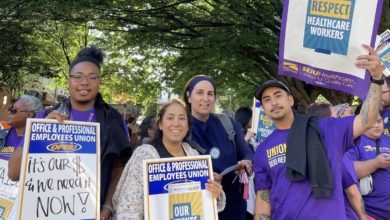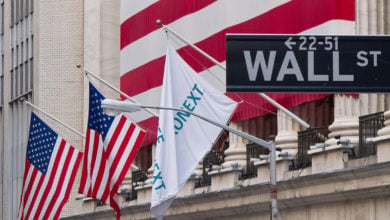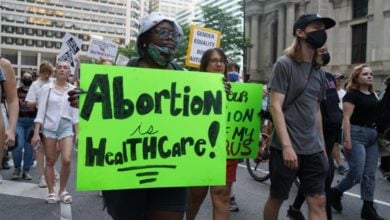
One of the most devastating and visceral losses a mother can endure is the death of a child. In New Jersey a woman recently lost her third child to a heroin overdose.
An out-of-work construction worker was found lifeless this year near New Jersey’s Passaic River. Next to him were heroin bags and paraphernalia. He was resuscitated, but will spend the rest of his life with long-lasting and debilitating physical consequences.
Last year a young college student was brought to the medical intensive care unit in northern New Jersey when an infected tissue fragment traveled from her heart to her brain. The condition was related to her addiction. She died as the infection corroded her body, shutting down each major organ.
I did not read about these three stories in the newspaper. As a nurse in a busy northern New Jersey hospital, I witnessed each victim’s suffering and pain. I met with and consoled their families as they tried to grapple with losing a loved one.
As sad as these stories are, they are not unusual. The opioid addiction epidemic is the most destructive public health catastrophe of the 21st century to date. According to the Centers for Disease Control, more than 400,000 people died from opioid overdose between 1999 to 2017. Opioids claimed more U.S. lives in 2017 alone than were lost during the entire Vietnam War.
But the pain of many has been the source of fabulous profits for a few. Recently released government data reveals in detail how this addiction crisis was created and fueled by drug manufacturers and distributors to increase profit margins.
Doctors paid off by drug producers endorsed dangerous medications with a high potential for abuse and dependency and encouraged other physicians to prescribe them. Insurance companies did their part by providing coverage for these addictive drugs, while often not covering other, safer but more costly treatments for pain.
The fortunes accumulated were blood money. No different than the infamous and criminal drug cartels in Colombia and Mexico, these corporations amass money and power by wantonly inflicting pain, suffering and death on hundreds of thousands of Americans.
The U.S. government had all the information on the unfolding of this manufactured crisis in a database. Instead of bringing these companies to justice, it helped to hide their transgressions.
76 billion opioid pills
The addiction pattern discussed here begins with doctors prescribing unlimited and/or unnecessary amount of highly addictive opioid pain medications, such OxyContin, Percocet or Vicoden, to patients who then become addicted. Once they are cut off by their legal distributor, they turn to the black market or seek street drugs to feed their addiction.
Working-class families have carried the brunt of this manufactured disaster that is destroying more lives every day.
According to new information obtained from the Drug Enforcement Administration’s ARCOS database , which tracks narcotics nationwide, drug companies released over 76 billion oxycodone (Percocet) and hydrocodone (Vicodin) pills between 2006 to 2012. The production of these opioids was monopolized by only three manufacturers accounting for approximately 88 percent of production, and only six companies were in charge of distributing 75 percent of all opioids between 2006 to 20012, according to a July 16 article in the Washington Post which analyzes the ARCOS data.
The information collected and kept by the DEA on the production and distribution of painkillers by big pharma was not released to the public until recently when a U.S. District judge lifted a protective order in place on crucial part of the ARCOS database. The data forms the basis of a suit in federal court by some 2,000 cities towns and counties claiming that these companies conspired to deluge the country with these addictive drugs.
Purdue sparked the epidemic
The Sackler family, owner of Purdue Pharma, L.P., sparked the opioid epidemic by flooding working-class communities, cities, and rural areas with OxyContin, its version of oxycodone, after the Federal Drug Administration approved oxycodone as a long-acting painkiller in 1995.
Lawsuits brought in 2014 by many states, counties and cities against this legal drug cartel revealed that through the marketing of opioids from 1995 to 2014 the Sackler family accumulated immense wealth reaching billions of dollars. Their fortune is blood money. Mafioso- style, Purdue Pharma pushed their product and saturated the market with OxyContin.
Manufacturing a crisis
The company deliberately mislead doctors and the public on the dangers of OxyContin. Physicians were told by company salespersons that the drug was nearly addiction risk-free. No evidence-based research was conducted to back that allegation. The truth was that it was highly addictive.
The company aggressively promoted the painkiller to doctors, showering them with bribes to prescribe the drug, and paying some physicians and non-profit groups to help market the drug as a safe and effective way to treat pain.
A study published this year by JAMA Network Open found that almost 500,000 payments totaling approximately $40 million were made to almost 70,000 physicians between 2013 and 2015.
One-out-of-12 doctors and one-out-of-five family physicians received bribes from big pharma to push these substances, according to the study. Counties where doctors receive payments had higher overdose rates than counties that were not exposed to bribery and kickbacks.
While the Sacklers may have sparked the crisis, and the transgressions of Purdue Pharma is best known, they were not the only pharmaceutical drug pushers, or even the biggest. Purdue controls only 4 percent of the opioid market. Even bigger producers were quick to cash in. SpecGx, a subsidiary of Mallinckrodt; Actavis Pharma; and Par Pharmaceutical, a subsidiary of Endo Pharmaceuticals, which together control 88 percent of the opioids manufactured, all fueled the addiction epidemic, according to the Washington Post.
Walmart, CVS, Walgreens join the profit frenzy
Drug distributers, which count every opioid pill they transport, and know where every pill goes, were part of the profit feeding frenzy. Just six companies distributed 75 percent of the pills from 2006-2012: McKesson Corp., Walgreens, Cardinal Health, AmerisourceBergen, CVS and Walmart. The number of pills transported by the companies soared as the epidemic raged, growing from 8.4 billion in 2006 to 12.6 billion in 2012.
The Cleveland law suit charges that the distributors allowed the drugs to reach the streets of communities large and small, despite persistent red flags that those pills were being diverted to the black market.
36 pills produced for each person in USA
Tracking the pills is a virtual road map of tracking the epidemic, according to the Washington Post. The states that received the most pills per person per year were: West Virginia with 66.5, Kentucky with 63.3, South Carolina with 58, Tennessee with 57.7 and Nevada with 54.7.
West Virginia had the highest opioid death rate during the period of the study. Rural areas were hit the hardest: Norton, Va., received 306 pills per person living there; Martinsville, Va., 242 per resident; Mingo County, W.Va., 203 per person in the town; and Perry County, Ky., 175 per resident.
From 2006-2012 the companies distributed enough pills to supply every adult and child in the country with 36 pills each year!
The depravity of their enterprise is as cruel and as cunning as the Medellin or Sinaloa cartels. But unlike Pablo Escobar and Chapo Guzman, the operation was mostly legal, and even in those instances that were not legal, the companies were protected by the United States government. Despite the deaths they have caused and the crisis they precipitated that is still unfolding, no pharmaceutical company or drug distributor executive has seen jail time or has even been held publicly accountable for their crimes.
Insurance companies, Medicare and Medicaid joined in
Private insurance companies were also a major contributor to the rampant drug crisis overwhelming many cities and counties across the country.
While narcotics abuse was surging, insurance companies refused to pay for alternative medicine such as steroid injections, physical therapy or nerve block therapies, treatments that have no potential for abuse. It was more beneficial to their ever-increasing bottom line to cover doctor prescriptions of OxyContin, Percocet or Vicodin than to approve coverage for other treatments that might be more appropriate for treating the patient’s condition, but cost the insurer more.
Refusing to cover alternative pain therapy was not limited to commercial healthcare insurance. Medicare and Medicaid refused to cover these therapies as well. According to an article published by the American Society of Interventional Pain Physicians, in 2013 and 2014 reimbursement cuts for coverage of epidural injections from private insurances and the Center for Medicare & Medicaid Services ranged from 19 percent to 56 percent.
This left many patients with no other option than to take highly addictive painkillers to alleviate their ailments.
The government cover-up
It is not surprising that the pharmaceutical companies staunchly oppose the release of this incriminating ARCOS data. But the DEA and the Justice Department also fought making the data public.
The scope of the DEA’s database was meticulous and extensive, allowing it to track not only the volume of opioids that were being produced, but also how much was delivered to each pharmacy nationwide. The U.S. government possessed an exclusive look at the opioid epidemic as it was unfolding, but fail to act.
The U.S. government had the opportunity to stop the opioid epidemic from devolving into a national crisis, yet chose to look the other way and protect the interest of drug companies instead of the interest of the people.
There were cases where drug corporations paid insignificant fines to the FDA and the Justice Department, or state lawsuits were settled monetarily. But this was only a slap on the wrist. The Justice Department has to date fined corporations who failed to report and prevent suspicious drug orders with only $500 million. This is a pittance compared to the billions the companies were making. But even with these small monetary settlements, the government signed on to agreements to keep this information on corporate drug transgressions in strict secrecy and away from the public.
This is not the first time that the U.S. government colluded with drug cartels to poison the public and wreak havoc in poor, working class communities. In the 1980s, the CIA under the Reagan administration facilitated the smuggling and trafficking of cocaine into the country in order to help fund the Contras in Nicaragua. The crack epidemic and the government policy called the “war on drugs,” which can also be described as a war on poor Black and Brown communities, devastated many inner cities, while creating misery and death.
Capitalism: Fertile ground for the opioid crisis
This opioid epidemic could only have occurred in a society where profit is king and hoarding wealth is a sacred doctrine. Only under a system such as capitalism can industry conglomerates manufacture a crisis in order to make billions of dollars even if it is at the expense of hundreds of thousands of lives.
The obsession with free markets and the lack of government regulation and oversight provided the fertile ground for this for-profit medical industry to create one of the most disastrous public health crises in modern U.S. history–almost half a million lives lost with no clear end in sight.
But all is not lost, as each day more people in the U.S. are starting to realize that a better system, and with it, a better society, is possible. Profit-hungry big pharma companies are only a symptom of an overwhelming destructive disease called capitalism. Socialism, which eliminates the profit motive and organizes society to meet human need, is the only cure.





